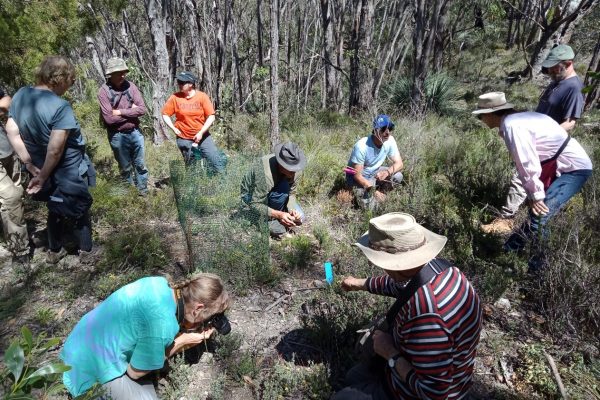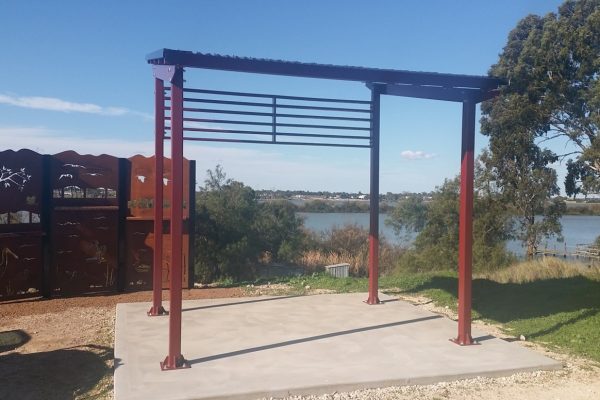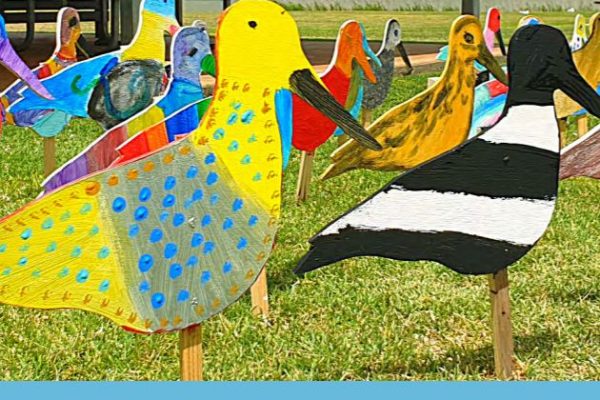Goolwa to Wellington Local Action Planning Association 1998-2018
Last week on the 17th October, board members, staff and supporters past and present gathered to celebrate 20 years of Goolwa to Wellington Local Action Planning Association.
Harry Seager, Board Member and past Chair, delivered the following address which summarises the achievements and history of GWLAP:
During the last years of the previous century there was a growing realisation the concerns of the conservation movement were paralleled by those of other land managers. Continuing degradation of soil and water resources, declining productivity were growing issues for farmers. The emergence of the Landcare movement saw this seemingly unlikely alliance establish a long-lasting movement to address these issues, focused on community level action. The growth of Landcare groups was assisted by State and Federal funding and the provision of local Landcare coordinator positions. The Community Action for the Rural Environment group, with State Government agencies such as the Murray Plains and the Southern Hills Soil Conservation Boards River Murray Water Catchment Board and Primary Industries assisted in this field.
In April 1997 initial discussions were held at a public meeting called by Christine Jones and Mary Crawford, supported by Glenn Gale from Primary Industries, Murray Plains Soil Conservation Board and the Murray Darling Basin Commission. Thus, lead to the formation of a steering committee, to guide the preparation of a Local Action Plan for the Goolwa to Wellington area. The committee formed was chaired by Chris Ainsworth, with Jan Whittle appointed as the Project Officer, to create the Draft Goolwa to Wellington Local Action Plan, which was subsequently released for public consultation in 1999. Early members included Jeff Jones and Jim Natt. This initial work was funded through the Natural Heritage Trust and The Murray Darling Basin Commission. Jim Natt took over the Chair in 1999 until Margaret Wilksch assumed the position in 2001, followed by Anne Hartnett in 2004, myself in 2007 and the current Chair Keith Parkes since 2013.
Jan Whittle continued as Project officer, then Manager until 2003, when her assistant Rachael Price (now Murphy) took over, until 2005, when she moved interstate. Jenny Dale then assumed the role until 2008, when Tony Randal, who had previously worked as a Project officer, returned to take the role as Manager. Tony served until 2013 when the current incumbent, Ross Oke, took on the position, now renamed General Manager.
During this time there have been 52 members of the Board, averaging just under five years each. The award for most tenacious must go to Margaret Wilksch, who has served for 19 years, including 3 as chair. I must also mention Beryl Belford who has provided many years of vigorous support, both whilst on the Board and through her roles with Bremer Barker Catchment Group amongst others. Our staff is a similarly persistent lot, with over 30 staff averaging around four years. However, this is heavily biased by the high numbers of staff during the CLLMM project in response to the Millennial drought. Current staff has averaged 7 years service, with Ben Simon our standout stayer with 11 years in the harness.
To all our members, Board and staff I thank you for the great service you have given and continue to give. This organisation arose in response to growing awareness of the need to address, in the broadest sense, land management issues across this area. For anyone who has a memory of 20 years past the positive changes in attitudes and actions is truly rewarding and encouraging for the future of this region. When the extent and scale of the on-ground works undertaken over the past 20 years is seen it is a truly remarkable effort. The level of community involvement and support continues to be consistently high and positive. Where windbreaks were negatively seen as a loss of valuable space they are now commonplace. The protection of water resources through fencing is no longer seen as extreme, but a mainstream and prudent action. The improvement in the protection and condition of remnant vegetation bodes well for it’s ongoing survival. Improved pasture management and production support has perhaps not achieved the same level of results through the GWLAP. I believe this reflects the decline in available funding and especially the retreat from the devolved grant models so widespread in the first decade of this organisation’s existence. Furthermore, there are often other support mechanisms available, through both levels of Government.
Very briefly GWLAP has assisted over 3700 landowners, protected 8300 ha of vegetation and planted 1.9 million tubestock, amongst its other tasks. Clearly, we have had good support and the list of other organisations we work with is extensive, reaching form Dawesley to Hindmarsh Island, Wistow to Wellington. The initial area covered by this organization has grown to include the Bremer Barker catchments, and now covers an area of 265,000 hectares. Effectively the GWLAP has united all the little Landcare and revegetation groups under one banner, without diminishing their independence but offering the advantages of a larger organisation.
Some of the most significant changes that have occurred over this period are the continual evolution and alteration to funding sources, motivations and delivery mechanisms. As previously stated the GWLAP was initially funded via the Natural Heritage Trust and the River Murray Water Catchment Board. When the decision came, at State level, to create a combined Natural Resources Management structure there was some consternation and concern as to how this would work. The interim period of the Integrated Natural Resources Management structure resolved many issues of concern. Area E funding provided the means to allow a relatively uninterrupted transition to the full implementation of the current model of Natural Resources Management Board. Clearly State and Federal funding continued, with the devolved grants programs being supplemented by other, more specifically targeted programs. Levels of funding fluctuated, sometimes unpredictably, with unpleasant consequences for the Board and particularly for staff, and a loss of corporate knowledge, skills and networks. From the initial $76,000 in 1997 funding grew steadily to around $400,000 in 2003, rising to $900,000 in 2005 only collapse to an average $450,000 in 2007-08.
The impact of the drought provided a significant boost to the GWLAP, as it became the lead not for profit administering body for the Coorong Lower Lakes and Murray Mouth projects (CLLMM). These projects were designed not only to undertake valuable environmental monitoring and rehabilitation work in response to the parlous conditions around the lakes, but also to provide positive support to the surrounding communities. I believe this was achieved well in excess of hopes and remains a tribute to the resilience and capacity of our local communities, and something of which the GWLAP and these communities can be very proud.
Other sources of funding continued and continue to change, with the Bush Bids program, the ongoing national Landcare program, Biodiversity Fund grants and most recently the 20 million trees program rising and falling according to the current political whim. From the $1.5 million received in 2009 when the CLLMM funds began flowing this increased to $4 million in 2014, with a further $3.4 million in 2015, to close out this program. Subsequently we have had to deal with a rapid reduction, from $1.9 in 2016 down to a current $1.17 in 2018. Obviously, the impacts have been severe and difficult to manage, as more competitive models of funding are introduced greater uncertainty makes this task more difficult.
Fortunately, we are a resilient lot. When these changes were mere shadows on the horizon we undertook a reassessment of our role and planned our response to such potentially disruptive changes. Over the last few years we have introduced and continue to expand a fee-for-service component in our operations, to become for self funding. While we have always done a little of this in 2013 this amounted to $13,000. By 2017 & 2018 this had grown to around $500,000, bolstered by work competitively secured through the 20 million trees program. To be clear this now represents around half our income and will become increasingly important into the future.
I have only briefly touched the surface of the past twenty years. There have overall been two seemingly contradictory themes from this organization over all this time: Change and Constancy.
A famous dead person said that change is the only constant. Certainly, GWLAP has had plenty of change to deal with. Changes to funding models, delivery models, the very words used to describe our task. How we should report, who we should report to, what we should include. Seemingly endless changes! Who amongst us remembers Tracker, the all-encompassing digital solution in search of a problem? Then there is the weather! Not only unpredictable but seemingly out of kilter with funding cycles more finely attuned to the fiscal calendar than our climatic realities.
Within all this there has been that overarching goal: to educate; to involve and to take action. This is clearly recognised by their peers, the community and by many others, at Local, State and federal government level.
For the GWLAP it is the people who provide the constancy, and similarly for all who support it, not just in terms of their commitment and persistence but also in their vision and the goals they wish to achieve, are achieving and have achieved.
Once again, I congratulate them on their efforts over the last 20 years and hope they can long continue in what is after all a very satisfying task.
- Ross Oke, Anne Hartnett, Tony Randall, Jan Whittle, Harry Seager, Margaret Wilksch and Keith Parkes cutting the cake
- Past and present Board members of GWLAP
- Past and present staff members of GWLAP
- Keren Stagg, Keith Parkes, Ben Simon and Will Miles
- Barry Lincoln, Simon Goodhand and Paul Johnston
- Bruce and Janette Brooks and Rose Ashton
- Sheree Bowman and Sylvia Clarke
- Tony Randall, Jan Whittle and Rick Trezona
- Karen Bradford, Anne Hartnett
- Sheree Bowman, Harry Seager and Ross Oke
- Keith Parkes, Keren Stagg and Margaret Wilksch
- Keith Parkes, Alyssa Lovelock, Jacqui Wilson and Keren Stagg
- Mike Bartlett, Beryl Belford, Ben Simon and Jim Belford
- Ian Grosser and Janet Klein


















